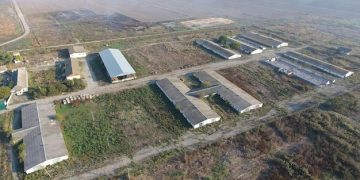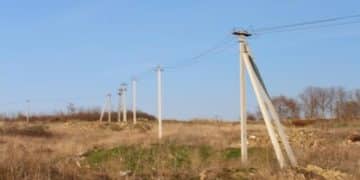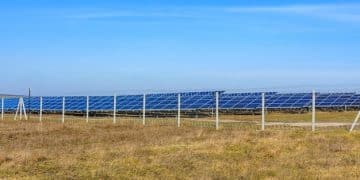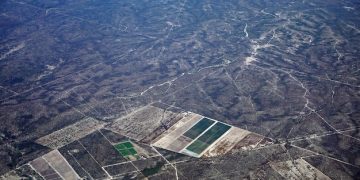Key Regulatory Obstacles to US Renewable Energy Projects
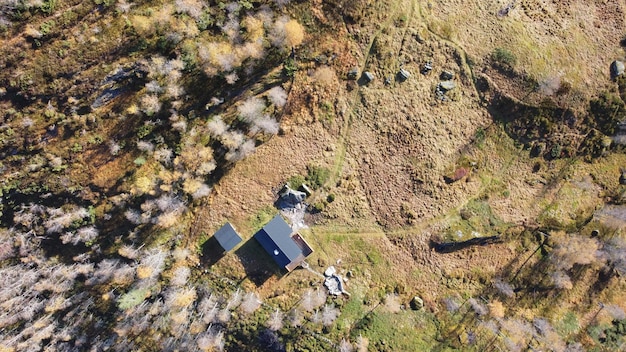
Key regulatory hurdles facing the development of new renewable energy projects in the US include permitting delays, grid interconnection challenges, and evolving federal and state policies, all of which can significantly impact project timelines and costs.
The development of renewable energy projects in the US is crucial for meeting climate goals and ensuring a sustainable energy future. However, these projects often face significant headwinds in the form of complex and evolving regulations. Understanding what are the key regulatory hurdles facing the development of new renewable energy projects in the US is essential for developers, policymakers, and anyone invested in the clean energy transition.
Navigating the Permitting Maze
One of the most significant regulatory obstacles for renewable energy projects is the complex and often lengthy permitting process. This process involves multiple federal, state, and local agencies, each with their own requirements and timelines. Delays in permitting can significantly increase project costs and timelines, making projects less economically viable.
Federal Permitting Requirements
At the federal level, renewable energy projects may require permits from agencies such as the US Army Corps of Engineers (for projects impacting wetlands or waterways), the Bureau of Land Management (for projects on federal lands), and the Federal Energy Regulatory Commission (FERC) for hydropower projects. Each agency has its own environmental review process, often requiring extensive studies and assessments.
State and Local Approvals
In addition to federal permits, renewable energy projects must also comply with state and local regulations. These may include zoning requirements, building permits, and environmental reviews. The complexity of these regulations can vary widely from state to state and even from county to county. Securing all necessary approvals can be a time-consuming and expensive process.

Here are some points that highlight the complexity of the permitting process:
- Lengthy Environmental Reviews: Environmental Impact Statements (EIS) and Environmental Assessments (EA) can take years to complete.
- Stakeholder Engagement: Engaging with local communities and addressing their concerns is crucial but can also prolong the permitting process.
- Coordination Challenges: Coordinating multiple agencies and stakeholders can be a logistical challenge.
- Changing Regulations: Evolving environmental regulations can require projects to adapt their plans, causing further delays.
In conclusion, navigating the permitting maze is a critical challenge for renewable energy developers. Streamlining the permitting process and improving coordination among agencies could help accelerate the deployment of renewable energy projects in the US.
Tackling Grid Interconnection Challenges
Another major regulatory hurdle is the process of connecting new renewable energy projects to the existing electrical grid. The grid interconnection process can be complex, time-consuming, and expensive, often creating significant delays and uncertainties for project developers. These challenges stem from technical requirements, capacity limitations, and regulatory oversight.
Interconnection Queues and Delays
Renewable energy projects typically must go through a lengthy interconnection study process to assess the impact of their project on the grid. These studies are often conducted by the local transmission provider and can take several years to complete. The backlog of projects waiting for interconnection studies, known as interconnection queues, can be extensive, further delaying project timelines.
Upgrades and Costs
Interconnecting a new renewable energy project to the grid may require upgrades to existing transmission infrastructure. These upgrades can be costly and may be the responsibility of the project developer. The cost of these upgrades can significantly impact the economic viability of a project, making it difficult to secure financing. Regulatory policies regarding cost allocation for grid upgrades vary across different regions, adding to the complexity.
Key obstacles to grid interconnection include:
- Capacity Limitations: The existing grid may not have the capacity to accommodate new renewable energy projects, requiring costly upgrades.
- Technical Requirements: Meeting the technical requirements for grid interconnection can be challenging, especially for variable resources like solar and wind.
- Cost Allocation: Determining who pays for grid upgrades can be contentious, often leading to delays and disputes.
Regulatory Oversight and Coordination
Grid interconnection is subject to regulatory oversight by FERC and state public utility commissions. These agencies set the rules and procedures for interconnection, which can vary significantly from region to region. Improving coordination among these regulatory bodies could help streamline the interconnection process and reduce delays.

In summary, tackling grid interconnection challenges is crucial for unlocking the full potential of renewable energy in the US. Addressing interconnection queues, streamlining cost allocation, and improving regulatory coordination are key steps to overcoming these hurdles.
Federal and State Policy Uncertainty
Uncertainty surrounding federal and state energy policies can create significant challenges for renewable energy project development. Policy changes, tax incentives, and regulatory mandates can all impact the economic viability and investment decisions for renewable energy projects. Developers need a stable and predictable policy environment to make long-term investments in renewable energy.
Federal Tax Incentives
Federal tax incentives, such as the Production Tax Credit (PTC) and the Investment Tax Credit (ITC), have been instrumental in driving the growth of renewable energy in the US. However, the on-again, off-again nature of these incentives has created uncertainty for developers. Extended and predictable tax incentives are needed to provide a stable foundation for renewable energy investment.
State Renewable Portfolio Standards
Many states have adopted Renewable Portfolio Standards (RPS), which mandate that a certain percentage of electricity be generated from renewable sources. These standards have helped to drive demand for renewable energy and support project development. However, the stringency and design of RPS policies vary widely across states, creating a patchwork of regulatory requirements.
Policy uncertainties influencing renewable energy projects include:
- Inconsistent Tax Incentives: Fluctuations in tax incentives can impact project financing and investment decisions.
- Policy Reversals: Changes in state or federal energy policies can undermine the economic viability of existing projects.
- Regulatory Mandates: Uncertainties regarding regulatory mandates can delay project development and create compliance challenges.
Evolving Energy Landscape
The US energy landscape is constantly evolving, with new technologies and market trends emerging. Policies need to be flexible and adaptable to address these changes. For example, the growth of energy storage technologies is creating new opportunities for renewable energy integration but also requires updated regulatory frameworks. Uncertainty around these emerging technologies adds to the regulatory burden.
In short, reducing policy uncertainty is essential for fostering a stable and predictable investment environment for renewable energy. Clear and consistent federal and state policies can help drive the continued growth of renewable energy in the US.
Environmental Regulations and Concerns
Renewable energy projects, while environmentally friendly in many respects, also face environmental regulations and concerns that can create hurdles in their development. These concerns range from land use and habitat impacts to visual impacts and potential effects on wildlife. Addressing these concerns requires careful planning, mitigation measures, and regulatory compliance.
Land Use and Habitat Impacts
Large-scale renewable energy projects, such as solar and wind farms, can require significant land areas. This can lead to habitat loss and fragmentation, impacting local ecosystems. Federal regulations require projects to conduct environmental assessments and develop mitigation plans to minimize these impacts. State and local regulations may also impose restrictions on land use.
Wildlife Protection
Renewable energy projects can pose risks to wildlife, including birds and bats. Wind turbines, in particular, have been shown to cause bird and bat fatalities. Federal laws, such as the Migratory Bird Treaty Act and the Endangered Species Act, protect certain species from harm. Developers must comply with these laws and implement measures to reduce wildlife impacts.
Environmental risks and regulatory challenges include:
- Habitat Disruption: Clearing land for renewable energy projects can disrupt habitats and impact biodiversity.
- Wildlife Impacts: Wind turbines and solar panels can pose risks to birds, bats, and other wildlife.
- Visual Impacts: Large-scale renewable energy projects can alter the visual landscape, leading to community opposition and regulatory challenges.
Community Engagement
Engaging with local communities and addressing their concerns is crucial for the successful development of renewable energy projects. This can involve holding public meetings, conducting outreach events, and incorporating community feedback into project design. Failing to address community concerns can lead to regulatory delays and opposition.
In conclusion, addressing environmental regulations and concerns is an integral part of renewable energy project development. Careful planning, mitigation measures, and community engagement can help minimize environmental impacts and ensure regulatory compliance.
Financing and Investment Barriers
Securing financing and attracting investment are essential for the development of renewable energy projects. However, renewable energy projects often face financing and investment barriers that can make it difficult to obtain the necessary capital. These barriers include high upfront costs, policy uncertainty, and perceived risks.
High Upfront Costs
Renewable energy projects typically require significant upfront capital investment. This can make it difficult for developers to secure financing, especially for smaller projects or projects in emerging technologies. Government incentives, such as tax credits and loan guarantees, can help reduce the upfront cost burden and attract investment.
Risk Assessment
Investors assess various risks when evaluating renewable energy projects, including technology risk, regulatory risk, and market risk. Projects with unproven technologies or uncertain regulatory environments may be perceived as riskier, making it more difficult to attract investment. Reducing these risks through policy stability and technology advancements can help increase investor confidence.
Financing and investment challenges include:
- High Capital Costs: The initial investment required for renewable energy projects can be substantial.
- Regulatory Uncertainty: Policy changes and regulatory delays can increase the perceived risk of renewable energy investments.
- Market Volatility: Fluctuations in energy prices and demand can impact the economic viability of renewable energy projects.
Access to Capital
Access to capital can be a limiting factor for renewable energy project development, particularly for smaller developers or projects in underserved communities. Innovative financing mechanisms, such as green bonds and crowdfunding, can help expand access to capital and support a wider range of renewable energy projects.
In summary, addressing financing and investment barriers is critical for accelerating the deployment of renewable energy in the US. Reducing upfront costs, mitigating risks, and expanding access to capital can help unlock the full potential of renewable energy investments.
Emerging Technologies and Regulatory Gaps
The rapid pace of technological innovation in the renewable energy sector is creating new opportunities but also posing regulatory challenges. Emerging technologies, such as energy storage and offshore wind, require updated regulatory frameworks to ensure their safe and efficient deployment. Gaps in existing regulations can create uncertainty and delay project development.
Energy Storage Integration
Energy storage technologies, such as batteries and pumped hydro storage, are playing an increasingly important role in integrating variable renewable energy sources into the grid. However, regulatory frameworks for energy storage are still evolving. Clear and consistent regulations are needed to address issues such as interconnection, grid services, and cost recovery.
Offshore Wind Development
Offshore wind energy has significant potential in the US, but its development faces unique regulatory challenges. Federal regulations govern offshore wind development in federal waters, while state regulations address projects in state waters. Coordinating these regulatory efforts and addressing issues such as environmental impacts and visual aesthetics are critical for realizing the potential of offshore wind.
Gaps and regulatory challenges include:
- Inconsistent Regulations: Varying regulations across states and between federal agencies create coordination challenges.
- Lack of Clear Standards: The absence of clear technical standards for emerging technologies can delay project development.
- Slow Adaptation: Regulatory frameworks often lag behind technological advancements, creating uncertainty for investors and developers.
Cybersecurity Concerns
As the energy system becomes more interconnected and reliant on digital technologies, cybersecurity becomes a growing concern. Regulations are needed to protect renewable energy infrastructure from cyber threats and ensure the reliability and resilience of the grid. Addressing these challenges is crucial for ensuring a secure and sustainable energy future.
In conclusion, addressing regulatory gaps and adapting to emerging technologies are essential for fostering continued innovation in the renewable energy sector. Clear, consistent, and forward-looking regulations can help unlock the full potential of new technologies and drive the clean energy transition.
| Key Point | Brief Description |
|---|---|
| ⏳ Permitting delays | Lengthy approvals increase project costs and timelines. |
| ⚡ Grid interconnection | Connecting to the grid requires upgrades and lengthy studies. |
| ⚖️ Policy uncertainty | Inconsistent incentives and mandates impact investment decisions. |
| 🌎 Environmental impact | Land use and wildlife concerns require careful planning and mitigation. |
Frequently Asked Questions
▼
The main challenge is navigating complex and lengthy permitting processes at federal, state, and local levels, leading to project delays and increased costs.
▼
Grid interconnection involves lengthy studies, potential infrastructure upgrades, and cost allocation disputes, slowing down the integration of renewable energy.
▼
Federal tax incentives like the PTC and ITC encourage investment, but their inconsistency creates uncertainty, impacting project financing and investment decisions.
▼
Environmental concerns include land use impacts, habitat disruption, and potential harm to wildlife such as birds and bats, requiring developers to implement mitigation strategies.
▼
Financing challenges can be addressed by reducing upfront costs through incentives, mitigating perceived risks by stabilizing policies, and expanding access to capital via innovative mechanisms.
Conclusion
In conclusion, addressing the key regulatory hurdles facing the development of new renewable energy projects in the US is essential for achieving a sustainable energy future. Streamlining permitting processes, improving grid interconnection, stabilizing policies, mitigating environmental impacts, and addressing financing barriers are all critical steps in unlocking the full potential of renewable energy and driving the clean energy transition.
